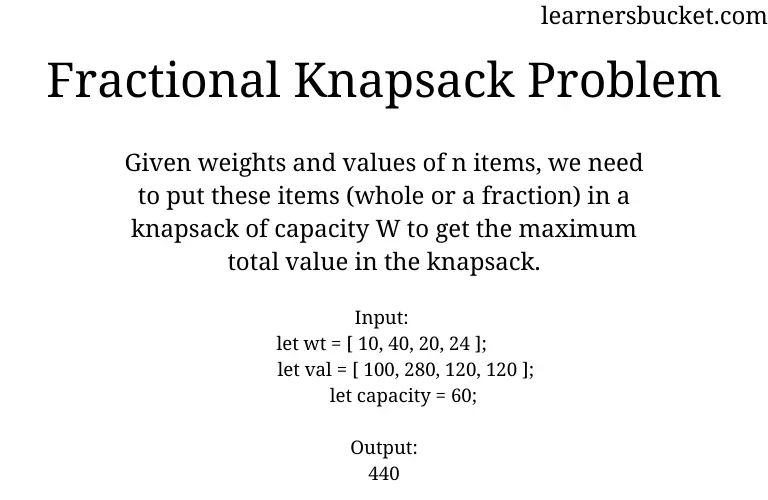
Note: The complete report for this project will be made avaliable for the time being. To run the implementations located in src simply select the '.ipynb' file. img - has the visualization gif used in the repo 😁.


Knapsack problem explained pdf#
pdf - where summary of the work is present.
Knapsack problem explained code#
src - or source code where the different implementations of the knapsack problem are located.This project was done using python (jupyter-notebook), and in the Project folder there are 3 other subsequent folders namely: Hence, in case of 0-1 Knapsack, the value of xi can be either 0 or 1, where other constraints remain the same. This is reason behind calling it as 0-1 Knapsack. In 0-1 Knapsack, items cannot be broken which means the thief should take the item as a whole or should leave it. This means that if the current items value + Vi1, ssi is less than or equal to the value above it, we must use the value on the previous item (or. The essence of this variation of the knapsack problem are the pre defined group of items that need to be added to the bag, while also satisfying the other constraints of the user and in the end applying the greedy approach (maggie on the image above) checks the remaining capacity and adds the items most suitable. However, this chapter will cover 0-1 Knapsack problem and its analysis. Quadratic knapsack problem (QKP) - has quadratic objective function and it is an extension of the linear Knapsack problem where there are additional terms in the objective function that describes extra profit gained from choosing a particular combination of items.DAA - Fractional Knapsack The Greedy algorithm could be understood very well with a well-known problem referred to as Knapsack problem. Problems like Travelling Salesman and Knapsack cannot be solved using this approach. The other extension of this problem is Polynomial Time Approximation Algorithm (PTAS) which is well explained in ( 4). In many problems, Greedy algorithm fails to find an optimal solution, moreover it may produce a worst solution. This signifies that the constraint are not complex and one can follow a Greedy approach to solve this problem. Linear knapsack problem (LKP) - the objective function and constraint(s) are linear.The objective is to maximize the sum of the profits of the chosen items without exceeding the capacity of the knapsack. An example can be where one travels to Dubai and has an unlimited card, but the only issue is that economy and business class only allows 48Kgs non negotiable per customer in the time of coronavirus 2021. The KP (see 28) is one of the most studied problems in OR.It consists of selecting a set of items that are associated with a profit and a weight.

So the time complexity analysis will be - T(n) T(n/2) + O(n). Now Instead of choosing random element at 1-step we can apply median finding algorithm to find median in O(n) times. The Knapsack Problem (KP) is a combinatorial optimization problem, where one wishes to fill his bag with enough items satisfiying his constraints ie weight and value. R is the set of ratios of profit/ weight of every object, where profit and weight of objects are given.And W is the Capacity of knapsack.


 0 kommentar(er)
0 kommentar(er)
